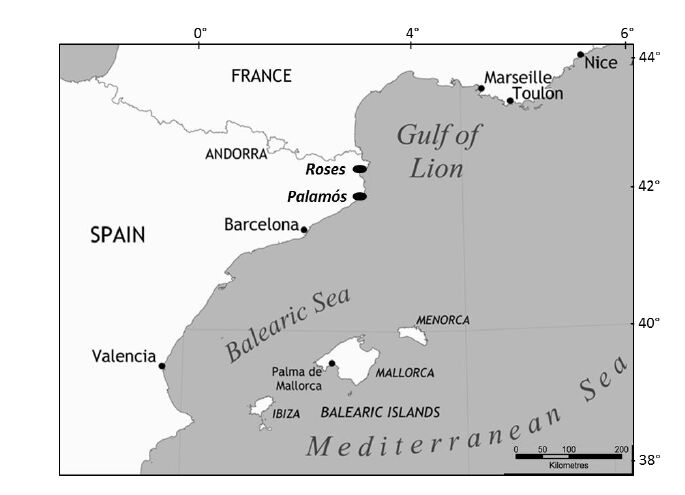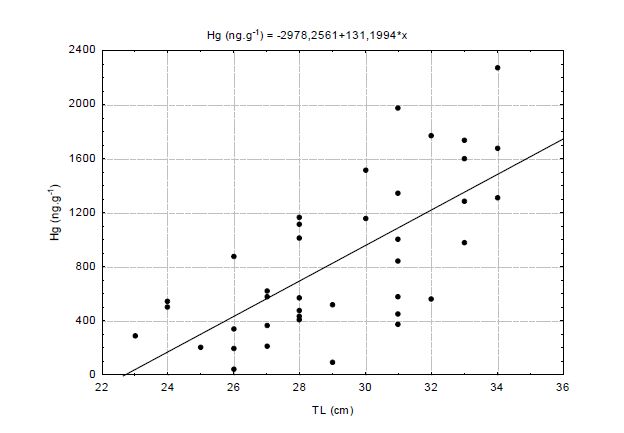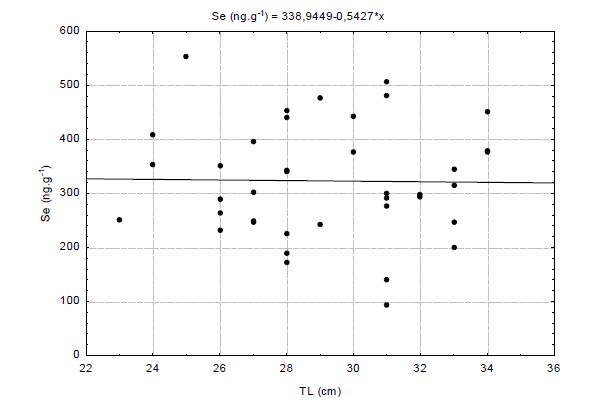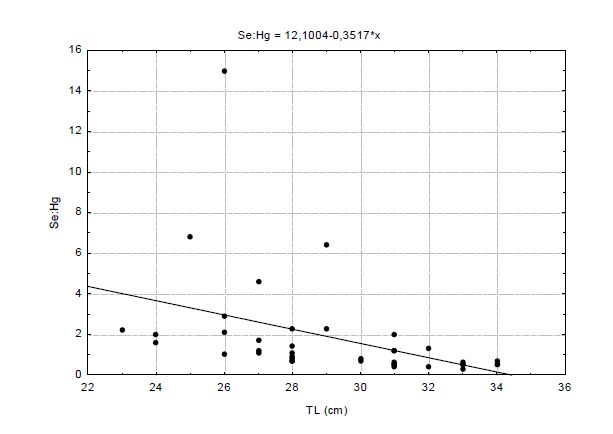1. Introduction
Human exposure to heavy metals depends on dietary habits and geographic location, and consuming edible marine species contributes most to mercury (Hg) intake [1]. In particular, tuna, swordfish, cod, and whiting are mostly responsible for methylmercury dietary exposure in adults, while these same species, with the addition of hake, are the most important contributors to exposure in children [2]. This is due to the high Hg concentrations in these species, and to their popularity as the most commonly consumed species. Fish and seafood are traditional components of the Mediterranean diet and the consumption of fish is particularly high in Spain, where annual per capita fish intake is estimated at about 45 kg, compared to around 25.5 kg in the European Union and 16.5 kg worldwide [3].
One important question today is whether the benefits of including fish in the diet may be offset by the presence of Hg in its meat. In fact, Hg has been associated with damaging cardiovascular and neurological effects [4], which impair neurodevelopment and can range from foetal death to delayed development and cognitive changes [5]. Maximum levels of this metal in fishery products are laid down by European Commission regulations. The Hg limit for fishery products is 500 ng g−1 wet weight (ww), but it is raised to 1000 ng g−1 ww for some fish species particularly prone to bioaccumulate this metal (such as brown ray, tuna, swordfish or scabbard fish) [6]. The maximum tolerable intake of these fishes for children in Spain has been established by the FAO/WHO [7] at 50 g/week for children from 3 to 12 years of age; it recommends that women who are pregnant, breastfeeding or of childbearing age and children under 3 years old avoid consumption. The European Food Safety Authority (EFSA) also recommends that toddlers, children and women of childbearing age consume species with lower Hg concentrations. The EFSA Scientific Committee recommends that each country consider its own pattern of fish consumption, especially the species consumed, and carefully assess the risk of exceeding the total weekly intake of methylmercury against the health benefits obtained from consuming fish/seafood [2]. The role of selenium (Se) should also be considered, as some studies suggest that a Se:Hg molar ratio >1 could protect against potentially adverse Hg effects [8,9,10].
The concentration of Hg in fishes presents significant interspecific differences reflecting trophic levels [11] and biomagnification [12,13,14]. Mercury tends to bioaccumulate in higher trophic level organisms [15]. The large predatory fishes reach high Hg concentrations and, within these species, larger individuals usually have higher concentrations than smaller ones, as a result of the age and, therefore, time of exposure to pollutants [16,17]. Contamination data in muscle samples of swordfish from markets in Madrid (Spain) were evaluated and a third part (around 35%) of the swordfish portions exceeded the maximum limit for Hg; particularly, some specimens reached levels up to 1900 ng g−1 [18].
Most authors agree that demersal predatory fishes reach higher levels of Hg concentrations than pelagic predatory species [19], but the data are controversial. For example, hakes (demersal predatory fishes) from the NW Mediterranean area showed quite high Hg concentrations in muscle (mean value of 617.4 ± 217.7 ng g−1) with a significant linear relationship between length and Hg concentrations in muscle [20], but never as high as the predator pelagic fishes.
On the other hand, the results concerning concentrations in benthic fishes are also contentious. Several authors reported that fishes feeding near the bottom, close to sediment, may accumulate Hg [14,21,22] in concentrations higher than predicted by their trophic position [23]. A study in the Central and Southern Mediterranean coasts of Spain [24] considered different feeding guilds and observed that mean metal concentrations were higher in benthic and more littoral fishes. However, another study in the Central Mediterranean found that values of Hg in benthic species (Solea solea, Diplodus sargus and Mullus barbatus) were always lower than those in demersal and pelagic predatory fishes [19].
Apart from habitat, other factors should be considered. For example, various external (marine environment) and internal (fish carcass parameters) factors have been shown to affect metal accumulation and inter-metal correlations within and among fish species, locations and seasons [25].
In NW Mediterranean waters, several species of Sparidae, mainly of the genus Diplodus, dominate fish assemblages in shallow rocky infralittoral habitats. Diplodus sargus (Linnaeus, 1758), the white seabream, is a littoral species inhabiting rocky bottoms and sand close to the rocks, at depths of up to 50 m in the Mediterranean [26].
The annual catches of this species are important, and has increased in recent years, as can be seen in Figure 1.
It is not a carnivorous species, but a common omnivorous fish, with bivalves representing the most important prey type, followed by algae, sea urchins, and barnacles [27]. The estimated maximum age for D. sargus in the Mediterranean is 9-10 years [26]. However, ages as high as 18 years (41 cm TL) from otolith readings and 16 years (45 cm TL) from scale readings have been reported for specimens captured in South Portugal [29]. Thus, although D. sargus is a species with a relatively long lifespan, it does not reach large sizes. The bigger specimens described have a maximum length of 45 cm, but the most common length is between 15 and 30 cm [30].
The aim of the present study is to analyse the concentration of Hg and Se in the muscle of D. sargus, a benthic, littoral and omnivorous species, and consider the relative importance of the habitat, diet, size and age in the accumulation of this heavy metal.
2. Material and Methods
To avoid possible local differences in pollution, samples used to quantify heavy metals were obtained from two NW Mediterranean commercial ports: Roses (20 individuals, total length between 23.5 cm and 31.3 cm) and Palamós (19 individuals, total length between 25.5 and 34.5 cm) (Figure 2). These two commercial ports have similar activity and this species is captured on a regular basis.
Each sampled specimen was measured, and a portion of muscle tissue of around 250 mg ww was extracted and stored frozen to analyse the muscle concentration of Hg and Se. All samples were digested in Teflon vessels with HNO3 (2 mL) and H2O2 (1 mL) (Merck, Suprapure) in an oven at 90 °C and left overnight. All materials used in the digestion process were thoroughly acid-rinsed. After digestion, samples were diluted with 30 mL of Milli- Q water.
Total concentrations of Hg and Se were quantified by inductively coupled plasma-mass spectrometry (ICP-MS, Perkin Elmer Elan 6000). The analytical procedure was checked using standard reference material dogfish (Squalus acanthias) muscle (DORM-2 from the National Research Council, Canada). Several analytical blanks were prepared and analysed along with the samples to determine the detection limits. The analytical process was performed at the Scientific and Technology Centres (CCiTUB) of the Barcelona University. All element concentrations are reported in ng g−1, based on wet weight values.
Molar concentrations of Se and Hg were obtained by dividing each concentration by its respective molecular weight (200.59 for Hg and 78.96 for Se) according to Burger and Gochfeld [8]. The correlations between the total length and the Hg and Se concentrations, between the total length and the Se:Hg molar ratio, and between the Hg concentration and that of the Se were analysed using the STATISTICA 6.0 package (Dell Software, Round Rock, Texas).
3. Results
For both elements, limits of detection were less than 0.1 ng mL−1 and recovery rates were 96.2% for Hg and 97.6% for Se of the certified values. Mean, maximum and minimum values of muscle concentrations of Hg and Se, as well as their molar ratios, are shown in Table 1.
Table 1. Muscle mercury and selenium concentrations in D. sargus as well as the molar ratio between Se and Hg, mean and standard deviation and maximum and minimum values.
|
Total length (cm) |
Hg
(ng g−1) |
Se
(ng g−1) |
Molar ratio
(Se:Hg)
|
| Mean |
29 |
846.71 |
323.12 |
1.85
|
| SD |
7.8 |
572.20 |
104.89 |
2.61
|
| Max |
34.5 |
2270.60 |
553.59 |
15.01
|
| Min |
23.5 |
44.60 |
93.65 |
0.36
|
Of the D. sargus individuals analysed, 26 out of 39 (67%) presented values of Hg clearly above the limit established by European legislation (500 ng g−1), while 15 specimens (38%) presented Hg values above 1000 ng g−1, the limit established by European Commission regulations for fish species particularly prone to bioaccumulation of this metal. Although high levels of Hg were observed in all sizes, the levels clearly increased in large, older fishes in the sample (Figure 3; r = 0.69, p < 0.05, n = 39). The Se concentration was not correlated with either the size of fishes (Figure 4) or the Hg concentration.
The Se:Hg molar ratio was negatively correlated with the size of fishes (Figure 5; r = −0.41, p < 0.05, n = 39). Thus, muscle level of Se in D. sargus can probably reduce the impact of high concentrations of Hg in the smaller specimens but would fail to in the bigger ones (>30 cm).
4. Discussion
Due to mercury's important neurotoxic capacity [31], its concentration has been carefully assessed in edible fish species of the Mediterranean, where the high levels usually found are due to the highly populated and industrialised Mediterranean coast [32].
These results displayed a high Hg concentration in muscle of D. sargus from the NW Mediterranean, well above the limit established by the European legislation (500 ng g−1), sometimes higher than the limits for predatory fishes (1000 ng g−1) and occasionally up to 2000 ng g−1. Luckily, the examined specimens were relatively rich in Se, which is necessary for selenoenzyme functions and offers some protection against Hg exposure and toxicity [33]. A substantial intra-individual variation in Se:Hg molar ratios was observed, but so was a general negative relationship between these ratios and fish size. Thus, younger specimens, with lower levels of Hg, benefit more from this protection.
In contrast to our results, a previous study performed with specimens from D. sargus collected in the Central Mediterranean (FAO zone 37 2.2) reported very low mean Hg levels (36 ± 73 ng g−1), while Hg was not detected in FAO zone 37 1.3, also situated in the Central Mediterranean [19]. Unfortunately, we do not know the size of the individuals analysed in this study. However, the mercury levels in the NW Mediterranean are probably higher due to the industrialization of the area and sediments deposited by the Rhone River.
The controversial results regarding the Hg levels in pelagic, demersal and benthic fish species commented on in the introduction to this work, together with our results, lead us to conclude that, in polluted areas, the time of exposure (the age) of the specimens plays a principal role in muscle Hg concentration. A study of 10 other similar species, which supports these results for D. sargus, observed that Pagellus erythrinus and Diplodus annularis also showed high accumulations of Hg, exceeding 500 ng g−1 in some individuals [24]. Those two species belong to the same family of D. sargus (Sparidae). Pagellus erythrinus is a benthivore feeder, preying mainly on epibenthic and infaunal organisms [34]. Diplodus vulgaris, like D. sargus, may be considered an omnivorous fish. Its most important prey type is bivalves followed by ophiuroids and polychaetes, and, somewhat less frequently, amphipods and benthic algae [27].
With regard to the age of D. sargus [28,29], smaller individuals in our sample would be about 3 years old and the larger ones would be nearly 9 years old. Ten years is the maximum age recorded for this species in the Mediterranean [28]. On the other hand, the Atlantic bluefin tuna (Thunnus thynnus), the largest predator usually mentioned as an example of a species that poses a health concern due to mercury concentrations, has an estimated life expectancy of around 35 years [35], although its average lifespan is of around 15 years [36]. This species is commonly 200 cm long but it can grow to a fork length of more than 300 cm [24]. Thus, D. sargus and T. thynnus are very different with regard to size but not so with regard to age.
Our results suggest that, although habitat, size and predatory habits are very important factors, age and therefore the time of exposure to pollutants must be considered the main factor for Hg bioaccumulation. In fact, older individuals usually show higher Hg levels than younger ones as a result of a longer exposure time [14,21,37,38,39], but in our opinion, relative less emphasis has been placed on this as the main factor.
Species such as the white seabream are less frequent in the diet than bluefin tuna, which is widely consumed in many different formats. Hence, despite the high concentration of Hg in white seabream, it should not be a big threat to human health.
Therefore, in special situations involving toddlers, children and women of childbearing age, species of fish recommended for consumption must be selected carefully, considering available studies for the fishing area. Indeed, the EFSA strongly recommends considering the species of fish consumed to carefully assessing the risk of Hg intake in each country, but more local information is needed to know how to follow these recommendations.
5. Conclusions
Demersal and pelagic large fish at the top of the food chain have often been considered the most problematic species in terms of bioaccumulation of Hg. However, high Hg concentrations have also been found in older specimens of Diplodus sargus, a littoral, benthic and omnivorous fish of a relatively small size. This suggests that estimated life expectancy of the species, and a longer exposure time to Hg, is the main factor that determines bioaccumulation. Therefore, in special situations involving toddlers, children and women of childbearing age, species of fish recommended for consumption must be selected carefully, considering available studies for the fishing area.
Acknowledgments
This research was carried out as part of a project funded by the University of Girona (UdG/3/Ref. MPCUdG2016-071).
Conflict of Interest
The authors declare there is no conflict of interest.









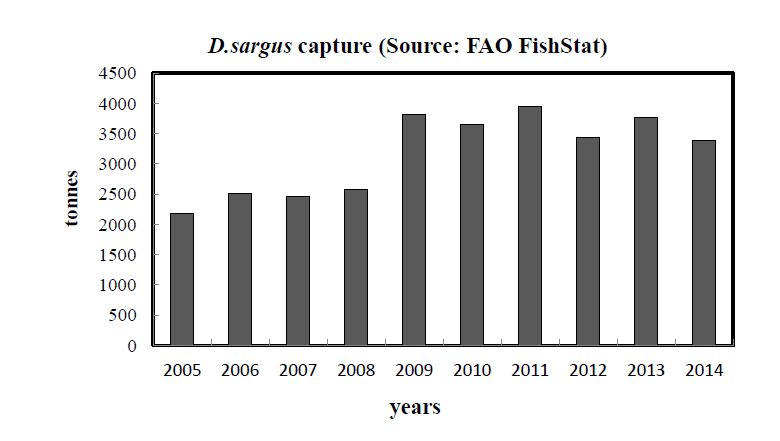
 DownLoad:
DownLoad: 